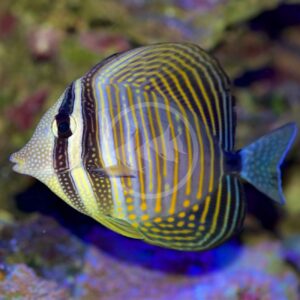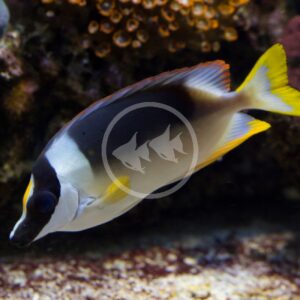

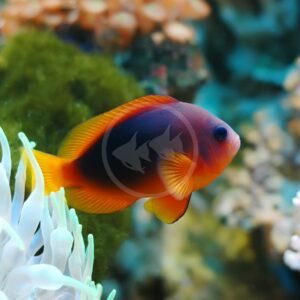
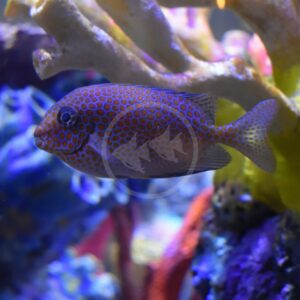
HAWK – CARIBBEAN REDSPOTTED Amblycirrhitus pinos
$74.99
The Caribbean Redspotted Hawkfish, or Redspotted Hawk for short, is found in the western Atlantic Ocean and Caribbean Sea. A typical hawkfish species in most regards, but the tiny and dazzling red dots on this hawk’s face give it an added charm. Hawkfish are extremely personable and fun to watch as they “hop” and perch around the aquarium. This behavior is due to their lack of a swim bladder that would otherwise enable them to continually swim in the water column like many of their tank-mates. The Redspotted hawk is very hardy, but can be somewhat aggressive and should not be added too prematurely into an aquarium or kept with small or very timid fish. An adult Redspotted hawkfish can reach a size of approximately 3-1/2″.
Care Level: Easy
Temperament: Semi-Aggressive
Reef Compatible: With Caution
General Description: The Caribbean Redspotted Hawkfish, or Redspotted Hawk for short, is found in the western Atlantic Ocean and Caribbean Sea. A typical hawkfish species in most regards, but the tiny and dazzling red dots on this hawk’s face give it an added charm. Hawkfish are extremely personable and fun to watch as they “hop” and perch around the aquarium. This behavior is due to their lack of a swim bladder that would otherwise enable them to continually swim in the water column like many of their tank-mates. The Redspotted hawk is very hardy, but can be somewhat aggressive and should not be added too prematurely into an aquarium or kept with small or very timid fish. An adult Redspotted hawkfish can reach a size of approximately 3-1/2″.
Diet Requirements: In the wild Redspotted hawkfish are carnivores. A diet consisting of various protein-based dried foods and frozen preparations such as brine shrimp, squid, and mysis shrimp will maintain optimal health and coloration.
Care Requirements: A minimum 55 gallon aquarium with a tight lid is ideal, as some hawkfish have been known to jump. Hawkfish enjoy a variety of rock work and crevices to take refuge and perch on. A Redspotted hawk would thrive with tank mates that have a similar temperament, are bold, and active. Keeping a single hawkfish species per aquarium is an absolute; the Redspotted hawkfish is intolerable of other hawkfish species. Additionally, hawkfish can sometimes harass other fish that behave similarily (i.e., other fish that lack swim bladders such as blennies). The Redspotted hawkfish is to be added into a reef aquarium “with caution” because invertebrates (e.g., shrimp, crabs) will likely become prey. Otherwise, they make generally good reef inhabitants. Recommended water conditions, 72-78° F, KH 8-12, pH 8.1-8.4, salinity 1.020-1.025.
Purchase Size: Small: 1″ to 2″; Medium: 2″ to 3″; Large 3″ to 4″
Note: Your item may not look identical to the image provided due to variation within species. Purchase sizes are approximate.
Dry goods orders are shipped via US Postal Service or UPS to the address provided at checkout based on the selection made in your website shopping cart. Product is carefully packed to help prevent any damage during shipping. Once processed you will receive a shipment notification via email with tracking number, and delivery notification. Please allow 48 hours for processing after your order is placed.
Perishable items (i.e. live plants, refrigerated/frozen foods) are shipped via US Postal Service 2-3 day to the address provided at checkout for a $25.00 flat rate charge. Items are packed with secure packing material and heat, cold, or Cryo packs as needed to maintain safe temperatures during transit. If one or more perishable items are in the shopping cart at checkout the $25.00 perishable shipping charge will automatically appear and need to be selected. Once processed you will receive a shipment notification via email with tracking number. Please allow 48 hours for processing after your order is placed.
Livestock (i.e. fish, invertebrates, coral) are shipped via UPS Overnight to the address provided at checkout for a $55.00 flat rate charge. Livestock is packed in insulated styrofoam boxes with secure packing material and heat, cold, or Cryo packs as needed to maintain safe temperatures during transit. If one or more livestock items are in the shopping cart at checkout the $55.00 livestock shipping charge will automatically appear and need to be selected. Livestock is shipped Monday through Wednesday ONLY (no weekend delivery is available) weather permitting, and we reserve the right to delay shipping until conditions are appropriate for safe arrival. Once your order is placed we will contact you to arrange the best shipping date based on these criteria. Someone must be available to receive the livestock order on the first delivery attempt. Once processed you will receive a shipment notification via email with tracking number. Please allow 48 hours for processing after your order is placed.
For mixed dry goods/perishable & livestock orders items will be shipped via their corresponding shipping methods outlined above. Dry goods will be shipped via US Postal Service or UPS based on your selection and checkout, while livestock will ship via UPS Overnight for a $55.00 flat rate charge. You will receive separate notifications and tracking numbers for the dry goods and livestock. Please note due to different carriers and shipping methods dry goods and livestock may arrive on different days.
Related products


TANG – YELLOW Zebrasoma flavescens
$174.99 – $399.99Price range: $174.99 through $399.99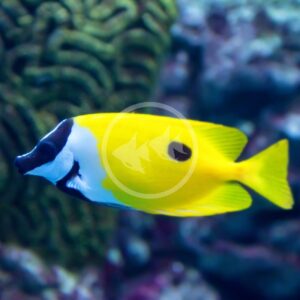

RABBITFISH – ONE SPOT FOXFACE Siganus unimaculatus
$119.99 – $169.99Price range: $119.99 through $169.99RABBITFISH – MAGNIFICENT FOXFACE Siganus magnificus
$199.99 – $349.99Price range: $199.99 through $349.99

BUTTERFLY – HENIOCHUS BLACK & WHITE Heniochus acuminata
$159.99 – $249.99Price range: $159.99 through $249.99ANGEL DWARF – PYGMY ATLANTIC / CHERUB Centropyge argi
$69.99 – $99.99Price range: $69.99 through $99.99

WRASSE – LEOPARD VERMICULATE Macropharyngodon bipartitus
$129.99